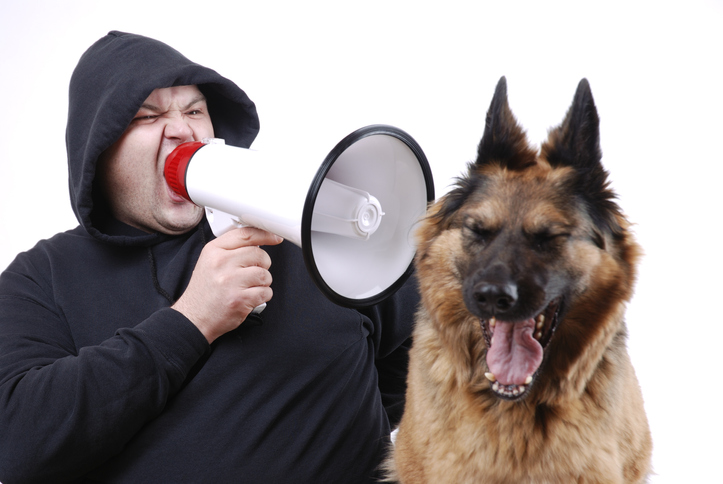You see that title and I bet you’re thinking, “of course I’d never let a trainer hurt my dog. Are you kidding me?”
Yet with some types of problems, my heart can be in my throat because I’m worried that the person who is shopping for trainers, may land in the hands of a trainer who may do just that.
Many years ago, before I had even considered becoming a dog trainer, my mother hired a shock collar trainer to help her with her dog. I was interested and came to her house when they were there.
“It doesn’t hurt”, the trainer said.
And he had her put it around her wrist and administered a low level shock. It felt like a static electricity shock when he tried it on me.
It didn’t seem to be that bad.
My mother started using it at a higher level when she was frustrated with the dog’s behavior. Since the dog didn’t yelp or scream, she figured it was fine.
Do Shock Collars Hurt Your Dog?
Anything that makes behavior decrease, is, by definition, a punishment. Punishment may hurt and it may be scary. A shock collar would not work to reduce behavior if the animal felt happy about it. If it isn’t painful enough, it won’t work.
Punishment can cause fallout that is not desired and can’t always be predicted.
Creating fears. A friend of mine took her dog to a shock collar training for rattlesnake avoidance. Her dog avoided rattling snakes, but her dog also became terrified of lawn sprinklers since they made a similar noise.
Suppressing behaviors. A dog may learn not to growl because they’re going to get hurt if they do. It may look like that’s working out well since aggressive behavior seems to have gone away. Until one day, that dog who has become afraid to growl, is in a position where he has no other way to communicate but to bite. That owner now has a dog that will bite without warning and is far more dangerous.
Dogs may get used to it. Over time, a dog may learn that they can’t really control the painful experience and they can habituate or get used to it. This means punishment will need to be cranked up higher to still work.
I’m not going to lie. If administered consistently, with excellent timing, punishment works. But is that the kind of relationship you want to have with your dog?
 You can meet all of your training goals without ever scaring, hurting, or even startling your dog.
You can meet all of your training goals without ever scaring, hurting, or even startling your dog.
Do Pinch and Prong Collars Hurt Your Dog?
Everything I’ve said about shock collars also applies to other correction collars. You jerk on the leash right when a dog sees a stranger wearing a hat. You jerked because the dog was pulling. But the dog was focused on the person wearing a hat. Your dog may now be afraid of people wearing hats.
But My Dog Needs Force
Some people think that their breed of dog has different needs. They need a firmer hand. Or they need more forceful methods.
“My breed is independent.”
“German Shepherds just need a strong hand and need to know who is boss.”
The reality is, that changing animal behavior is well researched, well understood, and is lawful. Behaviors that are reinforced increase. Behaviors that are punished decrease. That applies to teacup Poodles just as much as it applies to German Shepherds.
Sometimes it’s not the breed, but people’s perception of how their dog will respond to force-free training.
My dog isn’t food-oriented. Since we all need to eat to live, everything that eats will have some amount of food motivation. But if your dog is meh about food, you may not be using potent enough food. Most dogs don’t care much about Milkbones but will go crazy for your soft, smelly people food. Or your dog may be full. Or your dog may be thirsty. You can try training before you feed.
My dog is already overweight. You can cut back on your dog’s portions of regular food. You can use lower calorie treats like carrots. Be sure to use small sizes of treats even if your dog is big!
I don’t want my dog to only listen to me when I have treats. Fair enough! No one wants that! Not even us force-free trainers. And that’s why we don’t show the dog the treat and then ask for the behavior. Dogs can be quite clever and the smell of food, seeing you prepare the treats, or seeing that you’re wearing a treat pouch, can all be tip offs that it’s worth your while for your dog to obey you. But we want a dog who doesn’t need to see the food in order to obey.
So how do you fix that?
- Wear the treat pouch around the house and don’t train.
- Reach into the treat pouch but don’t give the dog anything.
- Prepare the treats and don’t train.
- Do everything you do when training except give the dog the treats. Your dog will learn that only obeying you predicts the treats and that even if nothing looks promising, it’s best to mind you!
Are force free trainers overly permissive? Do you let the dog just do what he wants?
No!
Dogs often do things that we humans don’t like. And we have the ability to change their behavior.
- We can reinforce what we want. If your dog comes when called, throw a treat party! Behavior that is reinforced, goes up!
- We can identify a behavior that can’t happen at the same time as the behavior we don’t want. What if your dog is jumping on people to say hi? It’s not possible to sit and jump at the same time. So instead of hurting your dog when he jumps up, you can teach him to sit to say hi.
- We can manage behavior. Sometimes, we don’t need to train at all. I once had a call from a potential client whose dog would get upset every time the pool service company came to clean the pool. He was worried the dog would bite the pool man. The pool service was at a predictable time and the dog was able to go in the house in that time window. They didn’t really need or want to train the dog. They just wanted the problem to be solved.
Don’t Let Trainers Hurt Your Dog
Don’t let any trainer tell you that you need to hurt or scare your dog in order to get obedience. And don’t let them tell you that the painful thing isn’t painful. If it wasn’t unpleasant, it wouldn’t work.
If you have a trainer who is using force and intimidation, don’t let good reviews make you overlook what your head and heart are telling you. You can get the same outcome without these things.
Many people tell me they felt uncomfortable shocking or jerking or smacking their dog. But they were paying an “expert” and so they did as they were told.
If your inner voice feels like it’s wrong, don’t let anyone tell you any differently.
If you need help because your dog won’t obey you, and you are looking for a dog trainer in the Sacramento area, I offer a free 15 minute phone consultation. And if you’re not in my service area, here is a great article on finding a qualified trainer by Joan Hunter Mayer of Inquisitive Canine
By working together, we can have happy dogs and happy humans!
Kayla Block, MA, CTC

Kayla, thank you for reminding folks that we don’t need to do anything that causes harm, fear, and pain to motivate our dogs to do what we want. It’s about teamwork and giving them the skills to make better choices. Bravo!! (PS: Thanks for the shoutout, I’m honored!)
It can be so hard for dog owners to know how to find effective, qualified help for their dogs. I love how your post helps people find skilled dog trainers. Thanks, Joan!